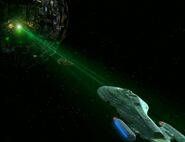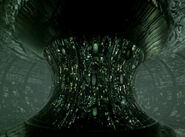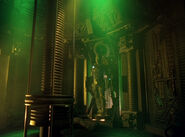The Borg long-range tactical vessel, commonly referred to by the Federation as a Borg sphere, was a sphere-shaped starship used by the Borg Collective during the late 24th century.
Technical data
Borg spheres were used by the Borg as scout ships or long-range tactical vessels. Borg spheres were also embedded into some Borg cubes, and were used as auxiliary craft. (Star Trek: First Contact; VOY: "Dark Frontier", "Drone")
Borg spheres had a crew complement of 11,000 Borg drones. (VOY: "Unimatrix Zero, Part II") The spheres were approximately 600 meters in diameter, and had an interior bay large enough to hold an Intrepid-class starship. (ENT: "Regeneration"; VOY: "Endgame")
Borg spheres had transwarp capability and ablative hull armor. They were also equipped with a tractor beam. (VOY: "Drone") Provided its deflector shields were down, a Borg sphere could be destroyed by a Sovereign-class starship with relative ease using quantum torpedoes. (Star Trek: First Contact)
History
In the year 2063, a Borg sphere from the future was used in an effort to prevent an historical event on Earth known as First Contact, an incident historically brought about by noted inventor Zefram Cochrane. The sphere launched an attack on Cochrane's hometown of Bozeman, Montana, but was soon destroyed by the Sovereign-class USS Enterprise, which had followed the sphere back through time. (Star Trek: First Contact) At least some of the remains of this sphere ended up in the Arctic Circle. In 2153, a team of scientists found the remains of the sphere there. (ENT: "Regeneration")
The same vessel had initially been launched from a Borg cube in the culmination of the Battle of Sector 001. After that incident, the sphere was observed to have time travel capabilities, by generating a temporal vortex through the controlled emission of chronometric particles; it was this method that enabled the sphere to travel to 2063. (Star Trek: First Contact)
In 2375, the crew of the USS Voyager successfully retrieved a Borg transwarp coil from a damaged sphere, as part of Operation Fort Knox. At the time, the sphere was only able to travel at warp 2 because it was regenerating from the damage. (VOY: "Dark Frontier")
In 2378, Starfleet attempted to destroy a sphere with a fleet of starships. The sphere was holding the USS Voyager, which was able to destroy the sphere from the inside using transphasic torpedoes. (VOY: "Endgame")
Design
A sphere had no living quarters, or a discernible engineering section for the propulsion systems. There was, however, a primary shield generator inside the shield matrix. The several transwarp coils of a sphere were contained inside specialized rooms called transwarp chambers that featured heavy shielding. (VOY: "Dark Frontier")
Ships of the Class
- Designated
- Undesignated
Appendices
Appearances
- Star Trek: First Contact
- VOY:
- "Drone"
- "Dark Frontier"
- "Think Tank" (display graphic)
- "Survival Instinct"
- "Tinker Tenor Doctor Spy" (simulation)
- "Child's Play"
- "Unimatrix Zero, Part II"
- "Endgame"
- ENT: "Regeneration" (debris)
Background
Following on from the sophisticated Borg Type 03, the sphere was the first simple shape devised as an alternative design of Borg spacecraft to the Borg cube and cubical Borg scout ship. Star Trek: First Contact co-writer Brannon Braga mused, "The idea that we would introduce that Borg ships had different shapes. They weren't all cubes. We have a sphere. It was like this great new idea, you know?" (audio commentary, Star Trek: First Contact (Special Edition) DVD/Blu-ray)
The official size comparison chart from First Contact defined the size of the Borg sphere as being 1500 feet (457 meters) in diameter. However, according to the size of the debris field, as referenced in ENT: "Regeneration", the radius was calculated at "about 600 meters in diameter."
Studio model
The Borg sphere was designed by illustrator John Eaves. During preproduction on First Contact, he submitted several concept sketches of the craft, at least two of which were dated January 1996. (Star Trek: The Next Generation Sketchbook: The Movies, pp. 204-206)
Designers of the Borg sphere made a conscious effort to make it look different from similarly shaped crafts in certain other science fiction movies, such as Star Wars and Starman. John Eaves later recalled, "Finding a new way to execute a spherical design that wasn't reminiscent of either film was difficult, but I did my darnedest to make it as different as possible." (Star Trek: The Next Generation Sketchbook: The Movies, p. 204) Production Designer Herman Zimmerman described the challenge of differentiating the Borg ship from the Death Star as "our biggest problem" and went on to say, "I think we managed that successfully. We just made it look completely different. The Borg, of course, have a unique look, and we Borgified that sphere." (The Making of Star Trek: First Contact, p. 71) Apart from Goodson, team members Barbara Affonso and Giovanni Donovan also worked on the model. (Cinefex, No. 69, p. 108)
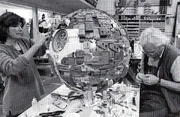
Affonso and Donovan working on the detailing of the sphere model
The minute detailing on the hull of the Borg sphere took its cue from that on the hull of the Borg cube from Star Trek: The Next Generation. Stated John Eaves, "The details are extremely faceted low relief, combined with high relief to cause a series of multiple planes. We also left cylindrical openings at the north and south poles where all the detail comes to an edge, then cascades down into a half sphere. Looking down on it, you can see a 'dome inside a dome.'" In one of the concept illustrations dated January 1996, Eaves hid the names of his wife Diane and his two daughters, Olivia and Alicia, among the Borg sphere's extremely intricate outer details. He added, "What's funny about this is that Playmates put out a toy Borg sphere–which just happens to contain the first initial of everyone's name." (Star Trek: The Next Generation Sketchbook: The Movies, pp. 204, 205 & 215)
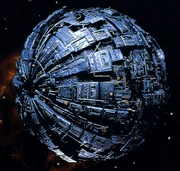
The finalized studio model
The external complexities of the Borg sphere meant it was easier to depict realistically with a studio model than with CGI. Hence, the craft was built as a motion-control model by Industrial Light & Magic, an effort led by ILM veteran model-maker John Goodson, responsible for supervising the model shop at ILM. (Cinefantastique, Vol. 28, No. 6, p. 23; Star Trek: The Next Generation Companion 3rd ed., p. 330) The model of the Borg sphere was two feet in diameter. "We vacuformed about fifteen different patterns that conformed to this spherical curve, and covered those with a lot of molded and cast pieces," explained Goodson. "Then we added tons of acid-etched brass over it, just like we had on the cube." (Cinefex, No. 69, p. 109) Despite appearing dark gray on screen, the model was actually painted mainly dark indigo (with silver and gold details). (Star Trek: The Next Generation Sketchbook: The Movies, p. 204)
That this craft's appearance is similar to the Death Star from the Star Wars films is not just coincidence, as ILM did all of the effects and modeling for Star Wars. The schematic of a Borg sphere shown in VOY: "Dark Frontier" depicts the craft's most striking resemblance to the Death Star.
For VOY: "Dark Frontier", Koji Kuramura digitally revamped the Borg sphere as a CGI model, at Foundation Imaging. (Star Trek Monthly issue 58, p. 46)
As of 2012, the original "Borg Sphere" physical studio model, virtually unmodified and having escaped the 40 Years of Star Trek: The Collection and It's A Wrap! auctions, is still in the possession of Paramount Pictures and has been on tour displays such as Star Trek World Tour, Star Trek: The Adventure, and Star Trek: The Exhibition as late as 2012. [1]


